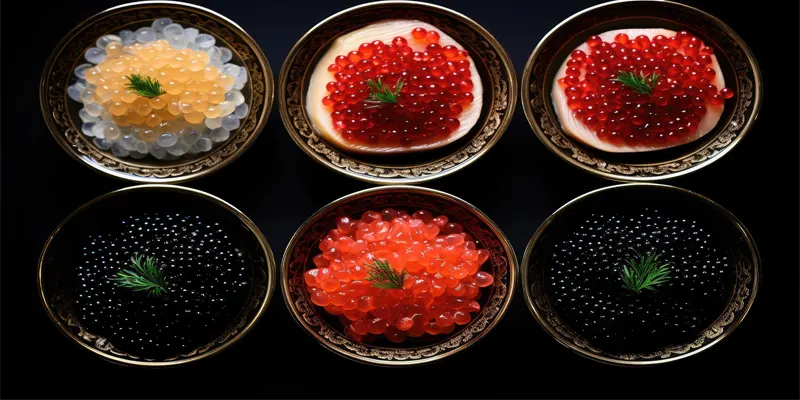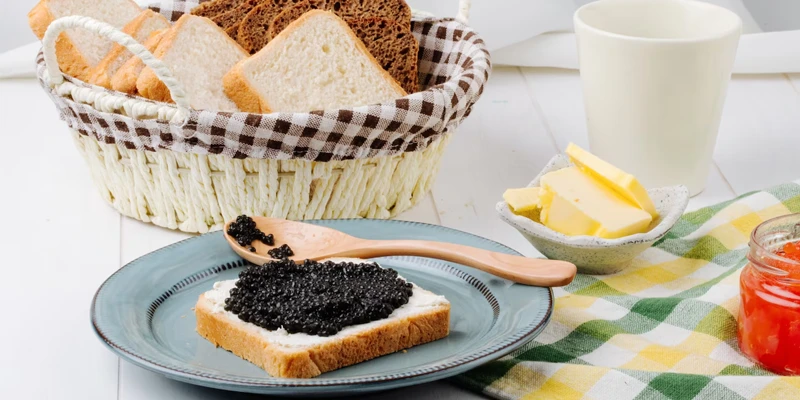Types of Caviar
Caviar fanatics are presented with an array of picks in terms of selecting their desired delicacy. The marketplace boasts several wonderful types, every with its specific traits and flavors. From the famed Beluga caviar to the lesser-regarded American caviar, let’s discover the diverse alternatives that grace the tables of connoisseurs global.
Beluga Caviar: The Jewel of Caviars
Beluga caviar, famend for its first-rate size and buttery taste, hails from the Beluga sturgeon. This distinctly sought-after caviar is characterized via its big, sleek eggs that variety in coloration from pale silver to deep black. With a sensitive, creamy taste that melts within the mouth, Beluga caviar has rightfully earned its recognition because the crown jewel of the caviar global.
Osetra Caviar: A Symphony of Tastes
Osetra caviar, derived from the Osetra sturgeon, offers a symphony of flavors that vary relying at the sturgeon’s food regimen and habitat. Ranging in shade from golden brown to darkish amber, Osetra caviar presents a nuanced taste profile which can range from nutty and fruity to briny and ambitious. Its medium-sized eggs burst with flavor, making it a favorite amongst caviar aficionados.
Sevruga Caviar: Delicate Elegance in Every Bite
Sevruga caviar, obtained from the Sevruga sturgeon, boasts small, distinctively grey eggs that deliver an intense burst of taste. With a strong taste that may be defined as slightly salty and earthy, Sevruga caviar is favored by means of folks that recognize a extra pronounced and tangy caviar enjoy.
American Caviar: A Local Delight
While the Caspian Sea area has long been related to caviar production, American caviar has carved its area of interest within the market. Sourced from a number of fish species which includes paddlefish and white sturgeon, American caviar gives a various range of flavors and textures. This nearby pleasure has gained recognition for its accessibility and unique flavor, imparting a compelling opportunity to traditional caviar alternatives.

Salmon Roe Caviar: A Vibrant Sensation
Salmon roe caviar, frequently referred to as “red caviar,” stands proud with its colourful orange hue and distinctively massive eggs. Bursting with a wealthy, oceanic taste, salmon roe caviar brings a hint of elegance to lots of dishes. Its pop-in-the-mouth texture and tangy flavor make it a famous preference for both culinary and visible enchantment.
Tobiko Caviar: A Delightful Burst of Color
Tobiko caviar, originating from flying fish, is widely known for its small, crunchy eggs that are to be had an array of colours inclusive of orange, pink, and black. With a moderate, slightly sweet taste, tobiko caviar offers a satisfying crunch and burst of color to dishes. Its versatility and playful look make it a favourite garnish in sushi and specific culinary creations.
Lumpfish Caviar: Petite and Flavorful
Lumpfish caviar, harvested from lumpfish roe, is recognized for its petite length and ambitious flavor. With eggs that variety in colour from colourful crimson to jet black, lumpfish caviar gives a salty and robust flavor which could beautify numerous dishes. Its affordability and unique appearance make it a famous desire for each professional chefs and home cooks.
How to Choose Caviar: A Guide to Selection
Selecting the proper caviar involves considering various factors which includes flavor alternatives, budget, and supposed use. For a honestly pricey experience, select Beluga or Osetra caviar with their larger, greater touchy eggs. If in search of a completely unique twist, discover American caviar or salmon roe caviar. Keep in mind that freshness, shade, and texture play key roles to your choice.
Caviar Storage Techniques: Preserving Delicacy
Proper storage is crucial to preserve the tremendous of caviar. Store your caviar within the coldest a part of your fridge, ideally between 28°F to 32°F (-2°C to 0°C), the use of an insulated container to prevent temperature fluctuations. Once opened, consume caviar internal a few days to savor its freshness. To save you flavor contamination, use a non-metallic utensil to serve and enjoy this unprecedented culinary treasure.


